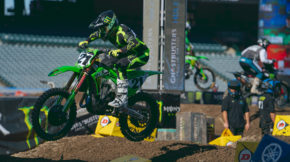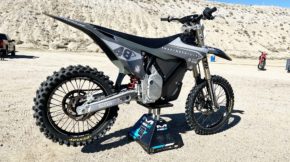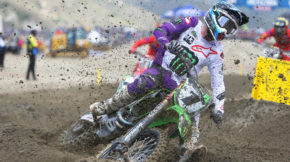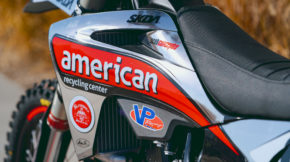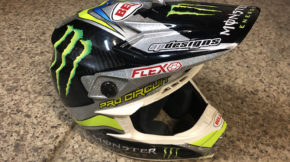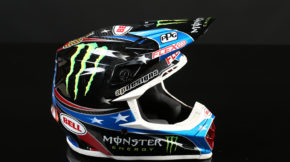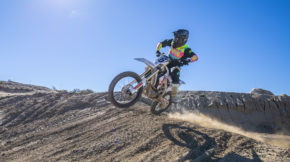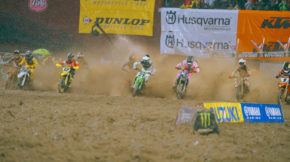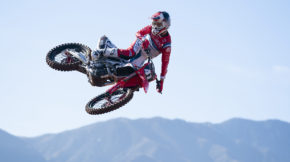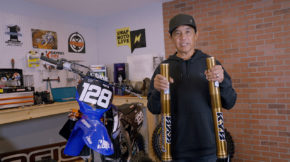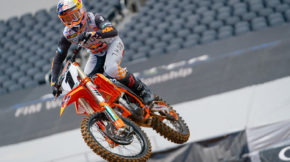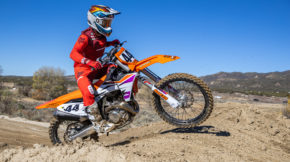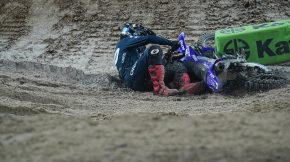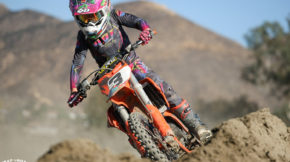Trail Tested | 2020 Husqvarna FE 350 and TX 300i
Share
By Pat Foster
 We decided to go as wide on the spectrum as we could get by pitting a TX 300i two-stroke against the FE 350 four-stroke. We also tried to get as diverse as we could with test riders, bringing longtime pro-test rider Pat Foster, and our friendly giant Dominic Gaytan to compare their impressions of where each bike excelled and where the other may perform better. Recent winter storms had left the desert dirt perfectly saturated with unbelievable traction and offered a little twist with fluffy snow over the caps of the foothills.
We decided to go as wide on the spectrum as we could get by pitting a TX 300i two-stroke against the FE 350 four-stroke. We also tried to get as diverse as we could with test riders, bringing longtime pro-test rider Pat Foster, and our friendly giant Dominic Gaytan to compare their impressions of where each bike excelled and where the other may perform better. Recent winter storms had left the desert dirt perfectly saturated with unbelievable traction and offered a little twist with fluffy snow over the caps of the foothills.
2020 Husqvarna FE 350
Dommer chose to start the day on the FE 350 as it would provide a more familiar platform to the standard motocross bikes he’s been spending time on recently. Equipped with a standard headlight, rear tail light, and handguards the 350 looks like a conventional Enduro bike. Armed with the standard electric start and bar-mounted map switches and traction control,the 350 platform is aimed to deliver a balance between the 450 rivaling power and the more nimble, lightweight 250 handling. However, this 350 power delivery is night and day different from the familiar FC 350 motocross bike we have reviewed in the past. Where the FC is quick, explosive, and loves to rev, the FE is mellow, broad, smooth, and easy to manage. This power delivery is the definition of putting easy to manage power to the ground. The crack of the throttle rolls on mildly, with a muted, almost electric feeling surge. The bike is quiet and offers a stealthy sound certain not agitate folks enjoying the outdoors. However, it feels as though the exhaust is extremely choked up, not allowing the engine to rev freely.
 Those looking for a smooth comfortable ride will love the long, linear, gradual power delivery offered by the FE. Frankly, it took us a while to get used to it. In situations where we were expecting a quick hit to blip over obstacles, wheelie through whoops, or gas it over fallen logs, the FE wanted to just tractor through things. The power did not offer any snap or excitement down low. This was definitely detrimental to our confidence at times especially when leading up to big hill climbs. Typically when attacking a large hill you want the motor to be singing with plenty of revs and momentum behind you by the time you hit the hill. With the choked up nature of the FE, it never felt as though we were approaching the steep inclines with enough momentum or revs to tackle what loomed in front of us. However, as we affectionately started referring to the FE as the “sewing machine motor” when we got into each climb the sewing machine would turn into a tractor, and the bike would lug down to a lower RPM and then stay there… continuing to quietly pull long beyond what we ever thought was possible. The bike was not screaming or revving it just slowly chugging up every hill we put in front of it. Did we want more power, more zing, more snap? Yes! Absolutely! But as we learned what the FE was capable of, and what to expect, it became a very effective weapon for us in the desert. Much like the power delivery, the suspension is also very soft and compliant. Super plush is the best way to describe the action of the FE. Larger guys and more aggressive riders will certainly long for firmer components as the sand whoops get deeper or the G outs more significant, but those looking for a bike that they can spend several hours on without fatigue will love the docile nature of the FE.
Those looking for a smooth comfortable ride will love the long, linear, gradual power delivery offered by the FE. Frankly, it took us a while to get used to it. In situations where we were expecting a quick hit to blip over obstacles, wheelie through whoops, or gas it over fallen logs, the FE wanted to just tractor through things. The power did not offer any snap or excitement down low. This was definitely detrimental to our confidence at times especially when leading up to big hill climbs. Typically when attacking a large hill you want the motor to be singing with plenty of revs and momentum behind you by the time you hit the hill. With the choked up nature of the FE, it never felt as though we were approaching the steep inclines with enough momentum or revs to tackle what loomed in front of us. However, as we affectionately started referring to the FE as the “sewing machine motor” when we got into each climb the sewing machine would turn into a tractor, and the bike would lug down to a lower RPM and then stay there… continuing to quietly pull long beyond what we ever thought was possible. The bike was not screaming or revving it just slowly chugging up every hill we put in front of it. Did we want more power, more zing, more snap? Yes! Absolutely! But as we learned what the FE was capable of, and what to expect, it became a very effective weapon for us in the desert. Much like the power delivery, the suspension is also very soft and compliant. Super plush is the best way to describe the action of the FE. Larger guys and more aggressive riders will certainly long for firmer components as the sand whoops get deeper or the G outs more significant, but those looking for a bike that they can spend several hours on without fatigue will love the docile nature of the FE.
2020 Husqvarna TX 300i
The TX 300i on the other hand offers all of the zappy hit you would expect from a 300 two-stroke. However, this two-stroke is likely different than anything you have ever ridden before. For starters, no mixing gas. What? That’s right. The TX300i utilizes a 39 mm throttle body which regulates the amount of air entering the engine via a butterfly valve, but unlike a four-stroke, fuel is not introduced to the mixture at this point. Rather 2-stroke oil (with a reservoir beneath the fuel tank) is mixed via an oil pump with the air to lubricant the crankshaft, cylinder, and piston. A pair of fuel injectors are mounted on the transfer ports at the rear of the cylinder that delivers fuel down directly into the transfer port. A throttle positioning sensor relays airflow data to the ECU which calculates the amount of oil and fuel delivered to the engine. Very sophisticated system.
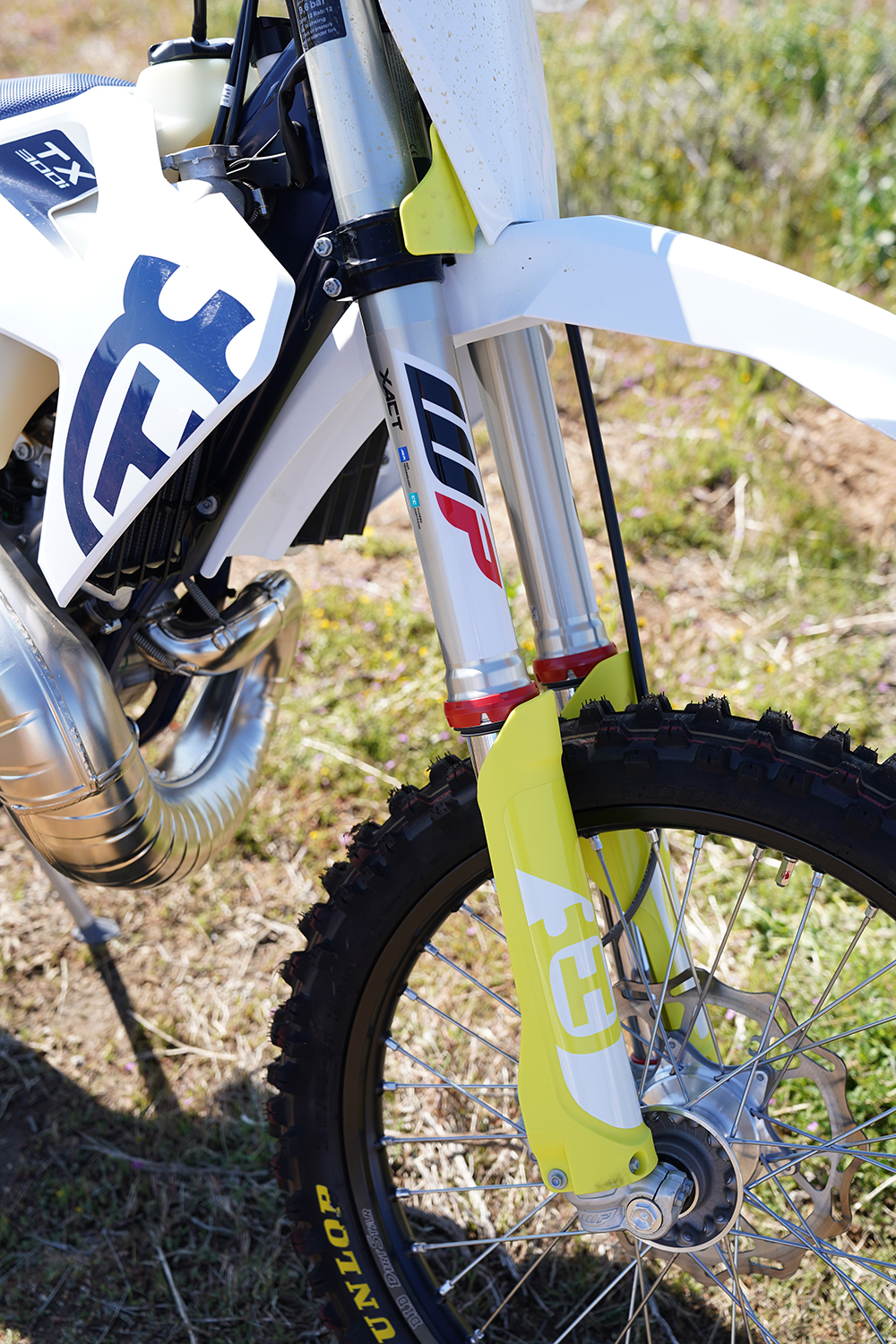 Suspension-wise, the TX300i feels much more like the motocross bikes we were accustomed to with far firmer suspension settings and a more substantial feel than it’s Enduro-based brother.
Suspension-wise, the TX300i feels much more like the motocross bikes we were accustomed to with far firmer suspension settings and a more substantial feel than it’s Enduro-based brother.







